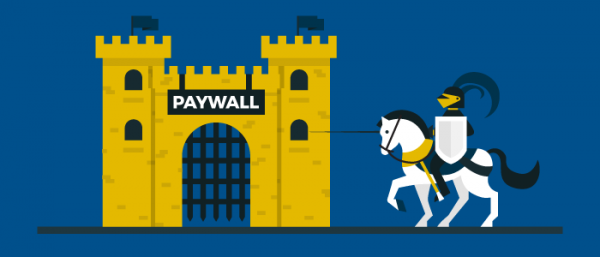
A recent article from Mediapost claims 40% of millennials personally pay for news (print or digital). Pay for news, you say? We think, when looking at the ratio of print to digital, that many of those millennials are probably subscribing to digital news, but we can’t say for sure. All we know is that digital ad and circulation revenues have doubled, and print ad revenues have, well, not.
Back in 2012, 9% of all people paid for digital news, according to the Reuters Institute at University of Oxford. In 2013, that number rose to 12%. How far can this number climb in the next five or ten years? Soon enough, 100% of millennials and all users will pay for media content in one form or another.
The best way to attract subscription revenue and get users to pay for content is with the paywall model.
There are two types of paywalls, a hard paywall, and a soft paywall (and varying degrees in between, as we’ll get to next)
A hard paywall model requires users to pay to access all content. There is no content available to read without registering first, whether registration is free or paid. SEO, as you might imagine, is poor for sites who have hard paywalls. Some circumvent this issue by giving away at least 300 words of each article before the call-to-action which suggests the subscribe. However, news organizations aren’t known for their search optimization savvy, so we generally don’t see a hard paywall as an SEO-friendly option, and they’re often done poorly.
[text_ad]
A soft paywall model, which is typically a metered paywall, may come in different levels of “softness” but refer to content that may be accessed up until a point. For example, a reader may get three articles for free before they are asked to subscribe. This is the way our client Yankee Magazine operates their paywall.
Back in 2014, Peter Marsh, from Newscycle, polled 45 newspapers who found 73% were charging for content. He found 40% using a hard paywall, and had a retention rate of 15-20%. He found the remaining 60% using a soft/metered paywall had a retention rate of 58.5% (up to 90%!) As I said, hard and soft paywalls are light descriptions, there are many variations of each. Here are a few of those not so black-and-white ways publishers are using paywalls.
How publishers are generating revenue with different paywall models

Throwing the gate up during crucial moments.
The Financial Times has a metered paywall that allows you to read three free articles. An article from Mediapost explains how FT uses relevant moments to build subscribers. “During Brexit, a major financial event for the U.K., the newspaper opened its paywall, yielding a 600% rise in digital subscriptions. While its average readership age is 50, 20% are millennials. Its high engagement rate enhances attractiveness to advertisers.”
Publishing enough free content to keep readers and advertisers happy.
The New York Times offers 10 free articles, and as the Mediapost put it, “[It] seems generous, but a meter lets people try content. Even if readers visit your site monthly without buying, you’re ensured continual inventory for advertisers. That’s the beauty of this tactic.”
Gating content while it’s fresh.
After 7 days, UK The Times will release content into the wild for free, so they bank on exclusivity of the content. This is a common tactic, however the trouble is that when headlines are available, topics can be Googled and brought to a competing site to find the same news. If you excel in superior content, your loyalists will want to hear it from you, but strangers may just pass on by. The Times says 55%-60% of readers subscribe.
Gating content after it’s expired.
Another tactic used by many publishers including those we work with, is to release content after a period of time. Say, 14 days if it’s news, or 90 days if it’s evergreen content. The value here is in search. If a paywalled page is properly optimized with enough copy and a good headline, your stories can be found months and years later, and a compelling enough headline on a single article could prompt subscription.
Slowly dripping content.
The Economist offers only to free articles per week, and they say 87% of users subscribe. They have an app called The Economist Espresso they call a “morning briefing” which sends content 6 days per week, but if you’re not a subscriber, you only get access to 1 article per week.
Pay as you go.
Some publishers choose the more complicated method of paying as you, or pay-per-article. We don’t usually recommend this solution because it’s a heck of a lot more work to get one-off buyers than to renew subscribers. Subscribers are automatically billed and have no barriers to entry. There’s no frustration when they realize they can’t access an article, they just log in and get access to everything.
On interesting example of kicking off a paywall with a bang was back in 2014. Esquire launched a new paywall featuring “The Falling Man” from 2003’s story of the September 11th attacks, reported The Huffington Post. The story, written by Tom Junod, was the main focus of the new paywall. Esquire asked for a donation of $2.99 for readers to continue reading through the entirety of the article. Readers don’t have to pay to access all of the article’s content, but if they did choose to donate, the money would go to a good cause. “The money will go toward the James Foley Scholarship Fund, in honor of the American journalist who was beheaded by the Islamic State militant group in August,” stated The Huffington Post.
How does your paywall operate? We’d love to interview you for a future post, just leave a comment below.


